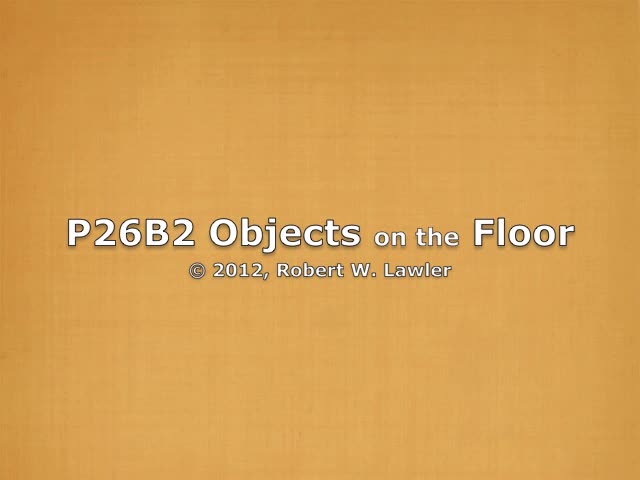
P26B2 Clip Notes
| Notes:n:nn | by Analyst, 11/03/2024 |
| Setting,Props | Cedar Hall, Family Room: |
| Actors,Aims | Peggy and Mom; Bob on camera. |
| Episode A: | Bob: It’s pretty clear she wants that stick, but just leave it there. Let’s see. Off the boundaries, huh? Mom: She was reaching for the orange stick. Bob: She started by going for the green one and lost it. She had to pick up the blue one, and now after, it was after the orange. This argues that if she was going after the one and got frustrated, she might be substituting, as the kind of thing she wanted, an object of the same sort, whatever that might mean to her. |
| Episode B: | Bob: Could you move the green one within her reach now? Just put it beyond the blue and orange and see if she goes after it again. [with the green stick placed, P moves, hurts herself on a block, which Mom removes, then P gets the stick] Bob: What’s the matter, Peg? [It appears P hurt herself on the end of the stick in her mouth?] Maybe we ought to bring everything together again and let her sort it out all over. I can’t imagine that she would be crying over this lost yellow cup, but who knows? [hidden hurts? as above?] |
| Episode C: | Mom: She’s been reaching for the green one [cup], but she can’t close her hand around it. She hasn’t had to grasp it. Bob: Well, put it within her reach and hold it up on the side. Hold it up so that she can grab the side. Mom: What’s the matter? Can I just put it down? Bob: Can you just put it down, I guess. I don’t know. |
| Episode D: | Bob: Well, let’s stop this for a while. Let’s see if the other children wan’t to play with Peggy as they said they would. Okay? Mom: [answer uncertain; Bob’s non-response implies “OK”] |
| Episode | |
| Summary by AI |
Observers note Peggy clearly wants a stick but is told to leave it, prompting observation. She first goes for a green stick, loses it, picks up a blue one, then shifts focus to an orange stick. This sequence suggests possible substitution: when frustrated, she seeks a similar object to meet the same goal. The team asks to reposition the green stick within her reach to see if she will pursue it again. After the green stick is moved, Peggy shifts, hurts herself on a block (which is removed), then obtains the stick. Peggy appears to hurt herself again, possibly on the end of the stick in her mouth, leading to crying. There is speculation about “hidden hurts” and whether distress could relate to a previously lost yellow cup. She has been reaching for a green cup but struggles to grasp it; she hasn’t yet fully closed her hand around it. Guidance is given to position the cup so she can grab the side; uncertainty follows about whether to set it down. The session is paused, with a plan to let other children play with Peggy as previously discussed. |
| Narrative by AI |
A recent observation session captured a young child, Peggy, exploring a small set of simple objects—colored sticks and cups—while adults provided gentle guidance. The setting appeared informal but intentional, with items placed just within or just beyond her reach to see how she would respond. The tone throughout was exploratory rather than instructional, allowing Peggy’s choices to shape the flow of the activity. Early on, her attention moved among several sticks—green, blue, and orange—suggesting a shifting target of interest. At one point, she seemed to abandon a pursuit of one stick and move toward another of a similar type. This prompted the adults to consider whether she was substituting one object for another when frustrated, choosing a different stick not just by convenience but as a stand-in for the kind of thing she wanted. It was a small moment that raised a familiar question in early development: how young children adapt goals when faced with obstacles. To test this idea further, an adult repositioned the green stick, placing it beyond the blue and the orange to see whether Peggy would still go for it. As she moved, there was a brief mishap—a bump against a block and later an apparent poke from the stick in her mouth—leading to momentary distress. The adults calmly removed the obstacle and continued, monitoring for signs of discomfort and emotional spillover. The episode illustrated how quickly exploration can turn, and how minor setbacks can influence attention and motivation. Attention then shifted to cups. Peggy repeatedly reached for a green cup but seemed unable to close her hand around it. The adults adjusted their support, holding the cup at an angle to make grasping easier, then debated whether to place it down so she could try independently. Her reactions—brief upset, renewed attempts—showed the interplay between motor readiness, object affordances, and the subtle impact of adult intervention. After a few tries, the group elected to pause and consider inviting other children to join, a natural reset that can diffuse frustration and re-energize interest. The session, though simple, highlighted several core features of early learning: curiosity, persistence, substitution when goals are blocked, and the value of tuning the environment to a child’s capabilities. It also underscored the importance of sensitive pacing—knowing when to scaffold, when to step back, and when to shift the context altogether. |
| Link Index | Panel P026, Language Development, Object Exploration, Social Interactions |
| Themes, Interplay |
